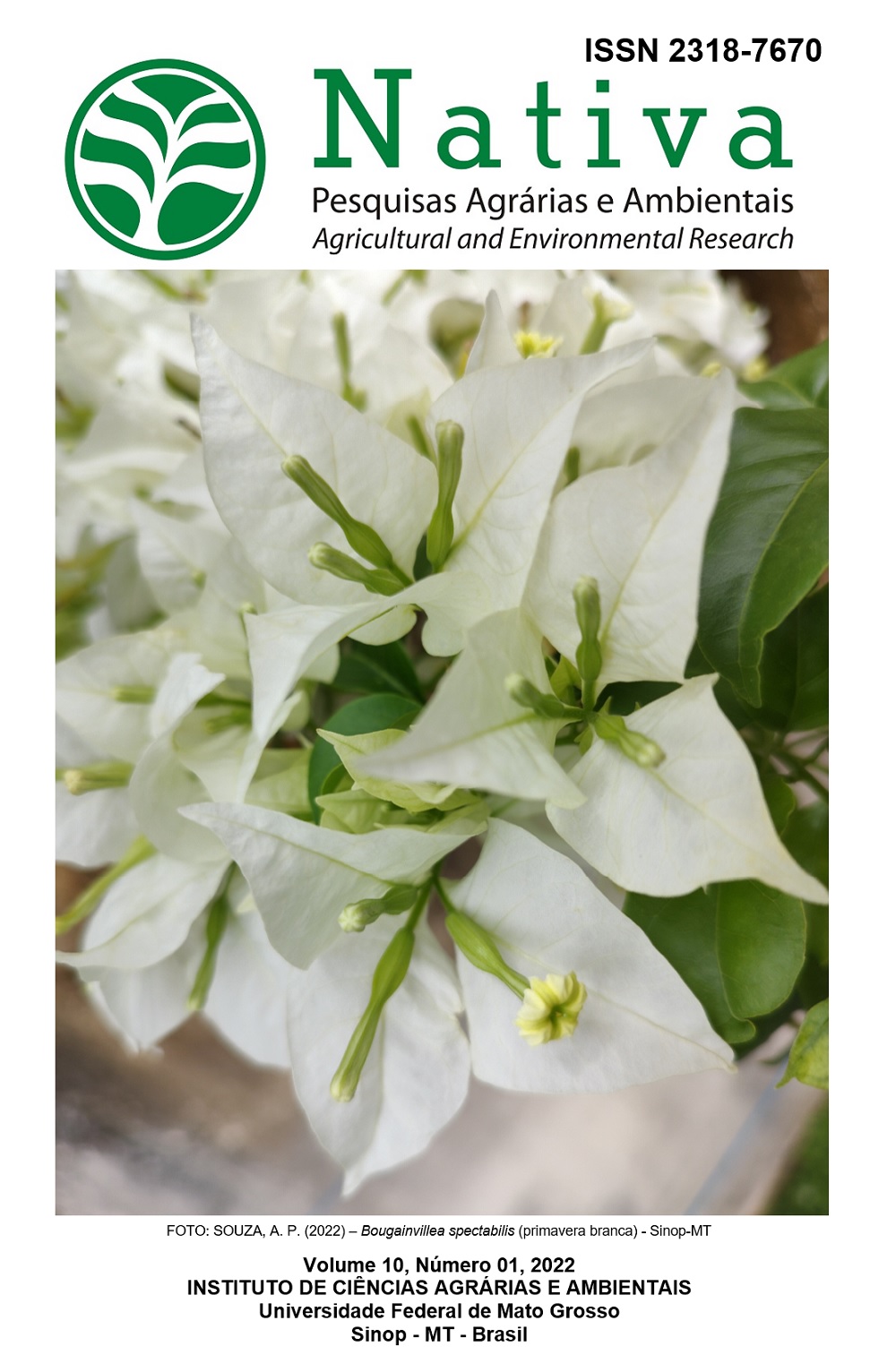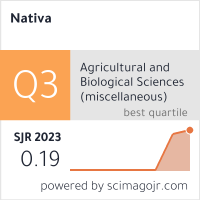POTENCIAL DE UTILIZAÇÃO DOS ÓLEOS FIXOS DE TUCUMÃS
DOI:
https://doi.org/10.31413/nativa.v10i1.13368Palavras-chave:
Arecaceae, qualidade, componentes funcionais, cromatografia gasosa.Resumo
As palmeiras são recursos vegetais de grande importância econômica e social no Brasil. Apesar da diversidade e amplo uso são pouco estudadas, havendo necessidade de mais pesquisas, principalmente, sobre a qualidade e composição de espécies ainda pouco exploradas. O trabalho objetivou caracterizar os óleos fixos extraídos do mesocarpo dos frutos de tucumã-açú e tucumã para identificar usos potenciais. Óleos fixos foram obtidos da Amazon Oil Industry LTDA, Ananindeua/PA, sob extração por prensagem a frio. Os tucumãs apresentaram diferenças em todas as propriedades físico-químicas avaliadas, com exceção do índice de peróxidos. Os óleos apresentaram elevado potencial em termos de constituintes bioativos, com destaque para o teor de clorofila total do óleo de tucumã (50,99 mg/100 g) e polifenóis extraíveis totais do óleo de tucumã (147,02 mg/100 g). Em relação ao perfil de ácidos graxos, o óleo de tucumã-açú apresentou elevado conteúdo de ácidos graxos insaturados, principalmente oleico e linoleico, com mais de 73%. Por ser fonte de compostos bioativos, há perspectivas de uso destes óleos como matérias-primas importantes para utilização em escala industrial e comercial, mas a qualidade destes óleos também implica num fator de relevância para o mercado consumidor, evidenciando necessidade de mais estudos.
Palavras-chave: Arecaceae; qualidade; componentes funcionais; cromatografia gasosa.
Potential for use of fixed tucumãs oils
ABSTRACT: Palm trees are plant resources of great economic and social importance in Brazil. Despite their diversity and wide use, they are little studied, requiring more research, mainly on the quality and composition of species that are still underexplored. The work aimed to characterize the fixed oils extracted from the mesocarp of tucumã-açú and tucumã fruits to identify potential uses. Fixed oils were obtained from Amazon Oil Industry LTDA, Ananindeua/PA, under cold pressing extraction. Tucumãs showed differences in all physicochemical properties evaluated, with the exception of the peroxide index. The oils showed high potential in terms of bioactive constituents, especially the total chlorophyll content of tucumã oil (50.99 mg/100 g) and total extractable polyphenols from tucumã oil (147.02 mg/100 g). Regarding the fatty acid profile, tucumã-açú oil had a high content of unsaturated fatty acids, mainly oleic and linoleic, with more than 73%. As a source of bioactive compounds, there are prospects for the use of these oils as important raw materials for use on an industrial and commercial scale, but the quality of these oils also implies a factor of relevance for the consumer market, evidencing the need for further studies.
Keywords: Arecaceae; quality; functional components; gas chromatography.
Referências
ABDEL KARIM, M.; EZDEHAR, A. E.; SALAH, H. Chemical constituents and antimicrobial activity of Sudanese Hyphaene thebaica L. (Arecaceae) fruit oil. The Pharmaceutical and Chemical Journal, v. 6, n. 1, p. 84-89, 2019.
ALMEIDA, D. T.; VIANA, T. V.; COSTA, M. M.; SILVA, C. S.; FEITOSA, S. Effects of different storage conditions on the oxidative stability of crude and refined palm oil, olein and stearin (Elaeis guineensis). Food Science and Technology, v. 39, n. 1, p. 211-217, 2019. DOI: https://doi.org/10.1590/fst.43317
AOAC. Association of agricultural chemists. Official methods of the association of the agricultural chemists: v. 2. 20rd.Pharmabooks: AOAC International, 3172p, 2016.
AOCS. Official methods and recommeded practices of the American oil chemist's society. 7th, 2nd. AOCS: Champaign, 1200p, 2017.
BRUINSMA, J. The quantitative analysis of clorophylls a and b in plant extracts. Photochemistry and Photobiology, v. 2, n. 2, p. 241-249, 1963. DOI: https://doi.org/10.1111/j.1751-1097.1963.tb08220.x
CODEX ALIMENTARIUS COMMISSION. Standard for edible fats and oils. Not covered by individual standards (Codex Stan 19-1981), 4p.2019
COIMBRA, M. C.; JORGE, N. Fatty acids and bioactive compounds of the pulps and kernels of Brazilian palm species, guariroba (Syagrus oleraces), jerivá (Syagrus romanzoffiana) and macaúba (Acrocomia aculeata). Journal of the Science of Food and Agriculture, v. 92, n. 3, p. 679-684, 2012. DOI: https://doi.org/10.1002/jsfa.4630
DINESH, B.; YADAV, R. B.; REDDY, D. A.; PADMA, S.; SUKUMARAN, M. K. Determination of ascorbic acid content in some Indian spices. International Journal of Current Microbiology and Applied Sciences, v. 4, n. 8, p. 864-868, 2015.
ENGEL, V. L.; POGGIANI, F. Estudo da concentração de clorofila nas folhas e seu espectro de absorção de luz em função do sombreamento em mudas de quatro espécies florestais. Revista Brasileira de Fisiologia Vegetal, v. 3, n. 1, p. 39-45, 1991.
FERREIRA, D. F. Sisvar: a guide for its bootstrap procedures in multiple comparisons. Ciência e Agrotecnologia, v. 38, n. 2, p. 109-112, 2014. DOI: https://doi.org/10.1590/S1413-70542014000200001
FLORA DO BRASIL 2020. Jardim Botânico do Rio de Janeiro. Disponível em: https://floradobrasil.jbrj.gov.br/. Acesso em: 03 jan. 2022. 2022.
FRANCIS, F. J. Analysis of anthocyanins. In: MARKAKIS, P (ed). Anthocyanins as food colors. New York: Academic Press, p. 181-207, 1982.
HARIYADI, P. Understanding the codex standard to ensure safety and quality of palm oil. International Journal of Oil Palm, v. 4, n. 1, p. 1-7, 2021. DOI: https://doi.org/10.35876/ijop.v4i1.58
HIGBY, W. K. A simplifield method for determination of some the carotenoid distribution in natural and carotene fortifield orange juice. Journal of Food Science, v. 27, n. 1, p. 42-49, 1962. DOI: https://doi.org/10.1111/j.1365-2621.1962.tb00055.x
JAPIR, A. A. W.; SALIMON, J.; DERAWI, D.; BAHADI, M.; AL-SHUJAʼA, S.; YUSOP, M. R. Physicochemical characteristics of high free fatty acid crude palm oil. OCL, v. 24, n. 5, p. 1-9, 2017. DOI: https://doi.org/10.1051/ocl/2017033
MAAIL, C. M. H. C.; ARIFFIN, H.; HASSAN, M. A.; SHAH, U. K. M.; SHIRAI, Y. Oil palm frond juice as future fermentation substrate: A feasibility study. BioMed Research International, v. 2014, e465270, p. 1-8, 2014. DOI: https://doi.org/10.1155/2014/465270
MCGUIRE, R. G. Reporting of objective color measurements. HortScience, v. 27, n. 12, p. 1254-1255, 1992. https://doi.org/10.21273/HORTSCI.27.12.1254
MELÉNDEZ-MARTÍNEZ, A. J.; VICARIO, I. M.; HEREDIA, F. J. Application of tristimulus colorimetry to estimate the carotenoids content in ultrafrozen orange juices. Journal of Agricultural and Food Chemistry, v. 51, n. 25, p. 7266-7270, 2003. DOI: https://doi.org/10.1021/jf034873z
MILLER, G. L. Use of dinitrosalicylic acid reagent for determination of reducing sugar. Analytical Chemistry, v. 31, n. 3, p. 426-428, 1959. DOI: https://doi.org/10.1021/ac60147a030
NAHUM, J. S.; SANTOS, L. S.; SANTOS, C. B. Formation of palm oil cultivation in Para’s Amazon. Mercator, v. 19, e19007, p. 1-14, 2020. DOI: https://doi.org/10.4215/rm2020.e19007
NOLASCO, C. L.; SOLER, L. S.; FREITAS, M. W. D.; LAHSEN, M.; OMETTO, J. P. H. B. Scenarios of vegetable demand vs. production in Brazil: The links between nutritional security and small farming. Land, v. 6, n. 3, p. 1-19, 2017. DOI: https://doi.org/10.3390/land6030049
PARDAUIL, J. J. R.; MOLFETTA, F. A.; BRAGA, M.; SOUZA, L. K. C.; FILHO, G. N. R.; ZAMIAN, J. R.; COSTA, C. E. F. Characterization, thermal properties and phase transitions of amazonian vegetable oils. Journal of Thermal Analysis and Calorimetry, v. 127, n. 2, p. 1221-1229, 2017. DOI: https://doi.org/10.1007/s10973- 016-5605-5
POMBO, J. C. P.; BARROSO, M. C.; RIBEIRO, D. C. S.; SOUSA, S. H. B. Qualidade físico-química dos óleos brutos de palma e palmiste. Revista Brasileira de Agrotecnologia, v. 11, n. 2, p. 479-484, 2021. DOI: https://doi.org/10.18378/REBAGRO.V12I2.8743
ROVERE, B. O.; RODRIGUES, J. H.; TELEKEN, J. G. Redução do índice de acidez através da neutralização e esterificação para produção de biodiesel. Brazilian Journal of Development, v. 6, n. 5, p. 24678-24686, 2020. DOI: https://doi.org/10.34117/bjdv6n5-064
RUFINO, M. S. M.; ALVES, R. E.; BRITO, E. S.; PÉREZ-JIMÉNEZ, J.; SAURA-CALIXTO, F.; MANCINI-FILHO, J. Bioactive compounds and antioxidant capacities of 18 non-traditional tropical fruits from Brazil. Food Chemistry, v. 121, n. 4, p. 996-1002, 2010. DOI: https://doi.org/10.1016/j. foodchem.2010.01.037
SANTOS, O. V.; SOARES, S. D.; DIAS, P. C. S.; DUARTE, S. P. A.; SANTOS, M. P. L.; NASCIMENTO, F. C. A. Chromatographic profile and bioactive compounds found in the composition of pupunha oil (Bactris gasipaes Kunth): implications for human health. Revista de Nutrição, v. 33, e190146, p. 1-12, 2020. DOI: https://doi.org/10.1590/1678-9805202033e190146
SILVA, R. S.; MIRANDA, P. H. O.; AMORIM, L. C.; FERNANDES, P. H. E.; AMARAL, E. V. F.; VERAS, B. O.; OLIVEIRA, F. G. S.; CORREIA, M. T. S.; ALMEIDA, J. R. G. S.; SILVA, M. V. Emerging source of bioactive compounds from Arecaceae family: a systematicreview. Research, Society and Development, v. 10, n. 10, e426101018994, 2021. DOI: https://doi.org/10.33448/rsd-v10i10.18994
STATISA. Production of major vegetable oils worldwide from 2019/2020. Statista. Available in: https://www.statista.com/statistics/263933/production-of-vegetable-oils-worldwide-since-2000/. Accessed: 07 Jul. 2020. 2020.
TAHIR, N. I.; ROZALI, N. L.; ZAKARIA, N.; OTHMAN, A.; RAMLI, U. S. Phytochemical insights on palm oils and extra virgin olive oil. Malaysian Journal of Analytical Sciences, v. 25, n. 4, p. 678-694, 2021.
YEMN, E. W.; WILLIS, A. J. The estimation of carbohydrate in plant extracts by anthrone. Biochemical Journal, v. 57, n. 3, p. 508-514, 1954. DOI: https://doi.org/10.1042/bj0570508
Downloads
Publicado
Edição
Seção
Como Citar
Licença
Copyright (c) 2022 Nativa

Este trabalho está licenciado sob uma licença Creative Commons Attribution-NonCommercial 4.0 International License.
Direitos Autorais para artigos publicados nesta revista são do autor, com direitos de primeira publicação para a revista. Em virtude de a aparecerem nesta revista de acesso público, os artigos são de uso gratuito, com atribuições próprias, em aplicações educacionais e não-comerciais.
A artigos publicados nessa revista, podem ser reproduzidos parcialmente ou utilizados como referência por outros autores, desde que seja cita a fonte, ou seja, a Revista Nativa.
Copyright for articles published in this journal are the authors, with first publication rights granted to the journal. The journal shows open access, and articles are free to use, with proper attribution, in educational and non-commercial.
The articles published in this journal may be reproduced in part or used as a reference by other authors, provided that the source is quoted.






